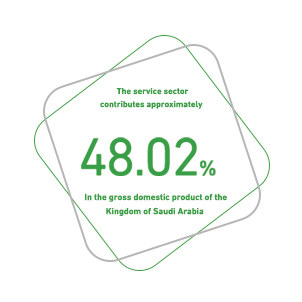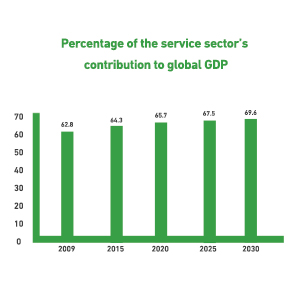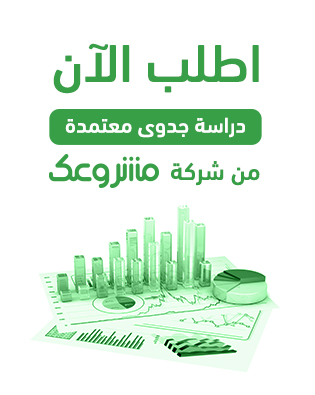The Service Sector in the GCC Countries
According to the macroeconomic theory of sectors, the economy is divided into three main and large sectors: the first sector, which focuses on extracting raw materials and includes mining companies, timber companies, oil exploration companies, as well as agricultural industries and fishing. The second sector is the one that relies on manufacturing goods and selling them, such as car manufacturing, furniture, clothing trade, etc. The third sector, known as the “services” sector, is responsible for providing and producing services, relying mainly on intangible goods such as entertainment, healthcare, transportation, hospitality, restaurants, and more. According to this theory, as countries progress, their economies increasingly rely on the third sector, unlike primitive countries, which depend mainly on the first sector (for example, in the United States, the service sector constitutes 85% of its economy).
Kingdom of Saudi Arabia:
The service sector is considered large when we scrutinize its activities. The sector includes wholesale and retail trade, restaurants and hotels, transportation and storage, information and communications, financial services, insurance, real estate, business services, social and personal services, and government services. Below are the key indicators of the sector in the Kingdom:
-
The contribution of the service sector to the Saudi GDP is approximately 48.2%.
-
The “wholesale and retail trade, restaurants, and hotels” sector contributes about 10.8% to the GDP.
-
The “transportation, storage, information, and communications” sector contributes about 6.6% to the GDP.
-
The “financial services, insurance, real estate, and business services” sector contributes about 6.4% to the GDP.
-
The “social and personal services” sector contributes 2.5% to the GDP.
-
The “government services” sector contributes 21.9% to the GDP.
According to the latest statistics, Saudi Arabia issued 100,944 new business licenses last year, bringing the total number of commercial licenses issued to 348,173. Wholesale and retail trade and motor vehicle and motorcycle repairs accounted for the largest share of new licenses, with 48,242 licenses issued. The second largest was accommodation and food services, with 16,531 licenses, followed by construction activities with 11,521 licenses.
Qatar:
-
The value of wholesale and retail trade activity in Qatar is estimated at 50,083 million Qatari Riyals.
-
The number of establishments operating in wholesale and retail trade reaches 11,139, with 213,954 workers employed in these establishments.
-
Compensation for workers in the wholesale and retail trade activity reached 11,288,877 thousand Qatari Riyals.
-
There are 2,396 establishments in the hotel and restaurant sector, employing 78,194 workers, with compensation amounting to 2,947,431 thousand Qatari Riyals.
-
The number of mobile phone subscribers (regular subscription) in Qatar is 976,015.
-
The number of mobile phone subscribers (prepaid services) is 2,941,556.
-
The total length of paved roads in Qatar last year was 2,224 kilometers.
-
The number of driver’s licenses issued last year was 242,923.
-
Compensation for workers in the transportation and communications sector was 24,338,223 thousand Qatari Riyals.
-
The number of insurance policies issued in Qatar last year was 715,897.
-
The number of establishments engaged in business services is 4,973, employing 215,285 workers, with compensation for workers in business services exceeding 15,347,819 thousand Qatari Riyals.
-
The number of workers in “social and personal services” in the private sector is 80,569, with compensation estimated at 6,127,645 thousand Qatari Riyals.
Kuwait:
-
Wholesale and retail trade contributes approximately 1,644.3 million Kuwaiti Dinars to Kuwait’s GDP.
-
Restaurant and hotel activities contribute about 418.6 million Kuwaiti Dinars to the GDP.
-
Transport, storage, and communications activities contribute about 2,554.5 million Kuwaiti Dinars.
-
The total length of paved roads in Kuwait is 91,340,068 square meters.
United Arab Emirates:
-
Wholesale and retail trade, including motor vehicle and motorcycle repairs, contributes 12.3% to the GDP (172,288 million AED).
-
Transport and storage contributes 5.9% to the GDP (82,461 million AED).
-
Accommodation and food services contribute 2.3% to the GDP (32,357 million AED).
-
Information and communications contribute 2.9% to the GDP (41,347 million AED).
-
Insurance activities contribute 9.6% to the GDP (134,773 million AED).
-
The number of insurance policies issued at the end of last year was 7,584,607.
-
Wholesale and retail trade accounts for 13% of the total workforce in the UAE.
-
The transport and storage sector accounts for 6.2% of the total workforce in the UAE.
-
Around 5% of the workforce is employed in accommodation and food services.
Oman:
-
The GDP of Oman is 29.3 billion Omani Riyals.
-
Wholesale and retail trade contributes 7% to the GDP, amounting to 2,064.7 million Omani Riyals.
-
Restaurant and hotel activities contribute 1.1% to the GDP, amounting to 308.6 million Omani Riyals.
-
Transport, storage, and communications contribute 5.9% to the GDP, amounting to 1,721.2 million Omani Riyals.
Global Service Sector
The service sector is the largest contributor to global GDP, accounting for more than three-fifths of the total output. Unlike manufacturing goods such as car production and furniture, the sector is based on providing intangible services like banking, healthcare, transportation, hospitality, entertainment, and more. The market value of the service sector was estimated at $10.814 trillion in 2020 and increased to $11.780 trillion in 2021, with a compound annual growth rate of 8.9%. After recovering from the impacts of the COVID-19 pandemic, global market experts predict the sector’s value will reach $15.684 trillion by 2025, with a compound annual growth rate of 7% over the coming years






